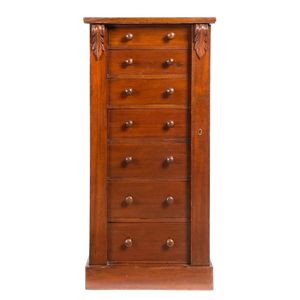Fluted Mahogany Wellington Chest with Seven Drawers
You must be a subscriber, and be logged in to view price and dealer details.
Subscribe Now to view actual auction price for this item
When you subscribe, you have the option of setting the currency in which to display prices to $Au, $US, $NZ or Stg.
- Fluting - A form of decoration found on many pieces of furniture, as well as ceramics, silver and clocks, in which round-bottomed grooves, of varying width and depth, are let into columns, pilasters, legs. As a general rule, flutes are cut in the vertical, though they may follow a turned leg in a spiral pattern. In cross-section, they may be described as a series of 'U' shapes, rising and narrowing at each end of the groove. Fluting is the opposite of reeding, with which fluting is often associated.
- Pilasters - In furniture a pilaster is a flattened column-like detail
applied to furniture. It is similar to a pilaster in architecture, but it is
typically smaller and less ornate. Pilasters are often used to decorate the
fronts of bookcases, cabinets, and other pieces of furniture. Pilasters can be
made of wood, metal, or other materials. They can be fluted, carved, or plain.
Pilasters are often used to add a touch of elegance and sophistication to
furniture. - Victorian Period - The Victorian period of furniture and decorative arts design covers the reign of Queen Victoria from 1837 to 1901. There was not one dominant style of furniture in the Victorian period. Designers used and modified many historical styles such as Gothic, Tudor, Elizabethan, English Rococo, Neoclassical and others, although use of some styles, such as English Rococo and Gothic tended to dominate the furniture manufacture of the period.
The Victorian period was preceded by the Regency and William IV periods, and followed by the Edwardian period, named for Edward VII (1841 ? 1910) who was King of the United Kingdom and the British Dominions and Emperor of India for the brief period from 1901 until his death in 1910. - Mahogany - Mahogany is a dense, close grained red-coloured timber from the West Indies and Central America. It was first imported into Europe in the the early 18th century and its use continued through the 19th century. It was popular for furniture making because of its strength, the wide boards available, the distinctive grain on some boards, termed flame mahogany and the rich warm colour of the timber when it was polished.. The "flame" was produced where a limb grew out from the trunk of the tree, and this timber was usually sliced into veneers for feature panels on doors, backs and cornices.
Some terms used to describe mahogany relate to the country from which it originally came, such as "Cuban" mahogany, "Honduras" mahogany etc. However unless the wood has been tested the names assigned are more a selling feature, rather than a true indication of the timber's origin.
This item has been included into following indexes:
- chests of drawers, period - Victorian 1,199
-
chests of drawers, style
- seven drawer 137
- Wellington 66
Visually similar items

An English mahogany Wellington chest, 19th century. 101 cm high, 48 cm wide, 34 cm deep

Victorian mahogany Wellington chest, the rectangular top above a bank of seven drawers within moulded pilasters with truss capitals, one side lockable, raised on a plinth base, height 110 cm width 53 cm depth 42.5 cm

A Victorian mahogany Wellington chest, attractive plain design with seven graduated drawers, carved corbels and turned wood handles (one missing). 60 cm x 42 cm x 119 cm

A Victorian cedar Wellington chest. 118 cm high, 54 cm wide, 37.5 cm deep.
